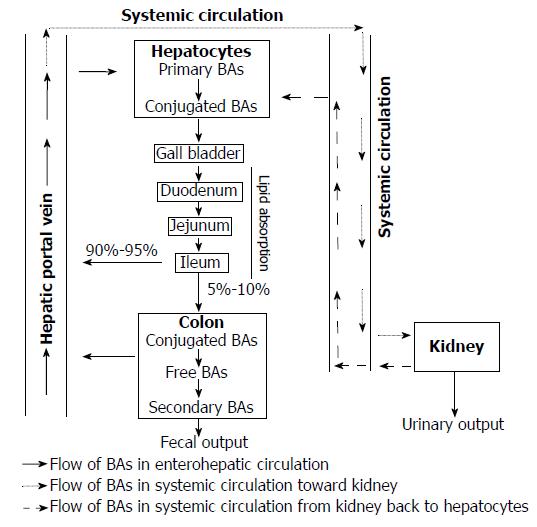Copyright
©The Author(s) 2018.
World J Clin Cases. Nov 6, 2018; 6(13): 577-588
Published online Nov 6, 2018. doi: 10.12998/wjcc.v6.i13.577
Published online Nov 6, 2018. doi: 10.12998/wjcc.v6.i13.577
Figure 1 Bile acid circulation.
Primary bile acids (BAs) are mainly synthesized in liver from cholesterols. After that, they are conjugated with glycine or taurine, excreted in the bile, and stored in the gallbladder. After a meal, conjugated BAs are stimulated to release into the intestinal tract for facilitating the digestion of dietary lipids and fat-soluble vitamins. Then, BAs are efficiently reabsorbed in the ileum and most of them (90%-95%) is transported back to the liver via the hepatic portal vein to be cleared, re-secreted in the bile, and ready for new circulation. This is called enterohepatic circulation. In addition to enterohepatic circulation, about 10% of the total BA pool reaches the systemic circulation to the kidney to be filtrated by the renal glomeruli and then return to the liver for subsequent circulation. A small amount of BAs (5%-10%), which escapes from ileum re-absorption, flows to the large intestines, where some of it is de-conjugated by bacterial bile salt hydrolases to become free BA and converted to secondary BAs. They are then reabsorbed into colonocytes to return to the liver for detoxification and then re-cycling. Only a small amount of these BAs (about 5%-10%) are lost via feces. BAs: Bile acids.
- Citation: Nguyen TT, Ung TT, Kim NH, Jung YD. Role of bile acids in colon carcinogenesis. World J Clin Cases 2018; 6(13): 577-588
- URL: https://www.wjgnet.com/2307-8960/full/v6/i13/577.htm
- DOI: https://dx.doi.org/10.12998/wjcc.v6.i13.577









